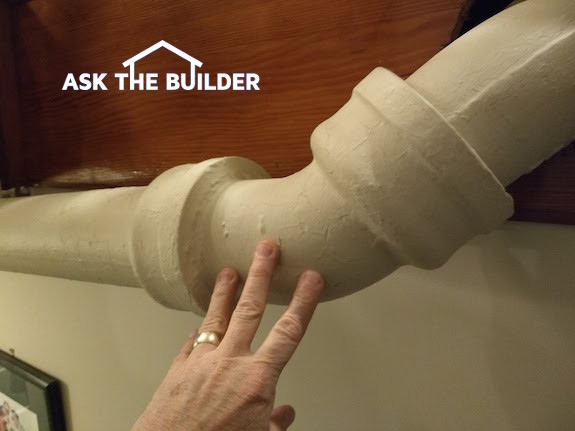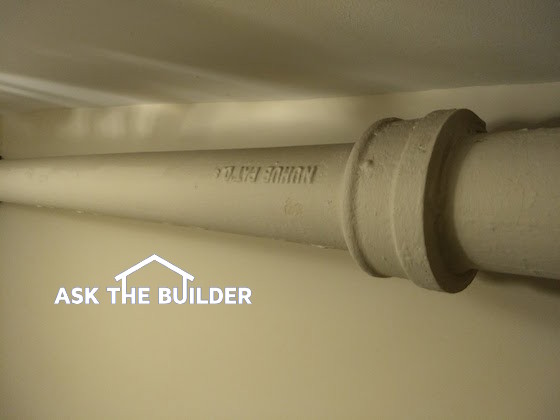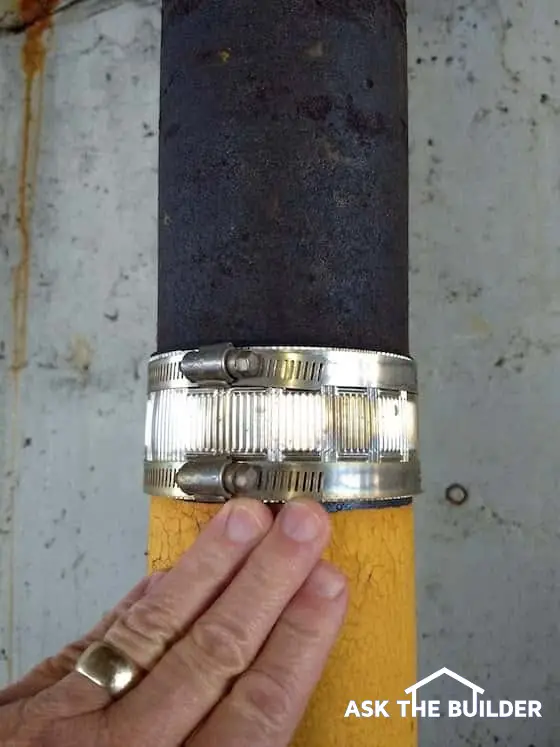PVC Pipe vs. Cast Iron Pipe

This is a cast iron pipe fitting. It's been painted countless times and is over 100 years old. It's above a staircase in one of the oldest buildings in downtown Southwest Harbor, Maine. The pipe is pitch black when new from the foundry. Copyright 2018 Tim Carter
PVC vs Cast Iron TIPS
- Cast iron is time-tested, durable and quiet.
- PVC pipe is easy to cut and noisy
- WATCH the PVC videos below
- Use cast iron for large drain stacks and PVC for vent pipes
- CLICK HERE to Get Tim's FREE & FUNNY Newsletter!
Cast Iron Pipe Is The Old Gold Standard
If you've not seen the guts of an old home, I'm talking about one built before 1920, you might not have ever seen cast iron drain pipes. It was the gold standard piping material used by plumbers for larger drain and vent lines for decades.
But the chemical industry explosion that happened in the 1960's changed the course of plumbing. Some may argue not for the better.
Related Links
Cast Iron Pipes are Easy To Install
Noisy PVC Pipe Complaints - Real Life!
Is Cast Iron Pipe Still Available?
Cast iron pipe is still made and it's better than ever. You purchase it at traditional plumbing supply houses, not big box retailers. New cast iron pipe uses rubber couplings and stainless-steel band clamps to make leak-proof connections. Watch this video to see how connections are made with ease:
Many homeowners associate cast iron piping with antiquated plumbing that's prone to developing leaks. Often people think that it clogs quite easily.
Conversely, many people think that modern plastic PVC plumbing piping is the miracle material. Well, both materials have advantages and disadvantages. Let's talk about both types of pipe and see what you think.
Free & Fast Bids
Is Cast Iron Pipe Durable?
Cast iron piping has been used successfully in plumbing systems for hundreds of years. In fact, in the year 1623 cast iron pipe was installed in the Fountains of Versailles in France.
That same piping is still functioning today. Thousands of miles of municipal water and sewer systems use cast iron pipe. The reason is long-term durability. Cast iron simply lasts.
Old cast iron pipe used to come in a regular wall thickness and an XH size. The XH meant Extra Heavy. It had thicker sidewalls and was much more durable. The XH lettering was cast into the side wall of the pipe and you can still see it if you look for it.
When Did PVC Pipe Start to Push Aside Cast Iron Pipe?
Virtually every residential home built prior to 1960 had some form of cast iron piping in its drainage system. The primary drainage stacks or pipes within the walls were constructed of cast iron.
The branches off of these stacks which connected to sinks, toilets, and tubs often used lead piping or galvanized-iron pipes.
Is Galvanized Iron Pipe Prone To Clogging?
Galvanized iron piping is especially prone to clogging. Within a decade or two of installation, the galvanized coating on the inside of the pipe wears aways or corrodes.
When this happens, the iron starts to rust and deposits start to form on the inside of the pipe causing the inner diameter of the pipe to constrict and get smaller and smaller. WATCH THIS SHORT VIDEO to show this exact problem with galvanized drain piping:
I've personally removed hundreds of these pipes which connected to kitchen or bathroom sinks. In virtually every instance, these pipes were clogged solid.
Do Cast Iron Stacks Clog Easily?
However, the cast iron vertical drain stacks only two to three feet away from the sinks were completely free of obstructions. Unfortunately, many homeowners and young plumbers don't realize this phenomenon falsely accuse the cast iron as a poorly performing product.

Here's a typical cast iron drain pipe. It's suspended from the ceiling in a stairwell in one of the oldest buildings in Southwest Harbor, Maine. You can see how the lettering is cast into the pipe. Copyright 2018 Tim Carter
Is It More Expensive To Install Cast Iron or PVC?
Years ago, residential construction labor costs were insignificant. Time was not always an issue with respect to how long a particular task took to complete.
For example, imagine how long it took to nail on those thin lath boards which allowed the plaster to be applied to the walls and ceilings of houses.
Think of the amount of time it took carpenters, using hand tools, to mortise hinges and locks into doors. The same is true for old style cast iron piping.
If you use modern cast iron pipe with no-hub rubber couplings, it takes just a few more minutes per joint to install than using PVC. One benefit of using cast iron is that you can make adjustments to the fitting angles after installation. You can't do that with PVC. Once you glue a PVC fitting onto a pipe, you only have seconds to get the adjustment perfect.
Do You Still Use Old Lead & Oakum?
You need to use lead and oakum if you're working with old cast iron. Old style cast iron piping was a chore to install. The plumbers had to pack oakum into each joint. Oakum was simply an oil-soaked rope that filled the 3/8-inch-wide gap where the male end of one cast-iron pipe mated up with the female hub of another piece of cast iron.
Once the oakum was taped tight into the joint and within a half-inch of the top of the hub, the plumbers would melt lead ingots and then pour this molten lead into the hub.
The lead solidified rapidly and the plumbers would use a flat tool to tamp and pack the lead in the hub so the joint became leak-free.
The job of installing cast iron was tough, time-consuming and dangerous.
Modern Cast Iron Pipe Is Easy To Install
The cast iron pipe available today looks somewhat similar to old cast iron. Old cast iron was indeed cast in molds. Modern cast iron is spun cast so the pipe wall thickness is much more consistent.
How Do You Connect Modern Cast Iron Pipe?
You connect modern cast iron using stainless-steel band clamps that squeeze full-sized rubber sleeves that surround the outer surface of the pipes.

My hand is touching a modern cast iron band clamp that prevents leaks where two pieces of pipe connect to one another. Copyright 2018 Tim Carter
The methods of installing the material have changed drastically. Gone are the oakum and molten lead. In their place, you now find vulcanized rubber seals and stainless steel band clamps.
Cast iron piping systems can now be installed in a fraction of the time it took to install them fifty years ago. In fact, modern cast iron piping can be installed just as quickly as plastic PVC piping.
Can You Adjust Cast Iron Fittings After Installation?
One of the amazing aspects of the modern cast-iron pipe is the fact you can easily adjust the orientation of the fittings AFTER you install them. You can do this by just loosening the screws on the band clamps and then twisting the fitting.
It's IMPOSSIBLE to do this with PVC or old cast iron. Once you glue PVC together you have between five and two seconds, depending on the diameter of the pipe, to make any adjustments.
With old cast iron, once you poured in the molten lead, you're toast. You can't make any adjustments.
Cast Iron Is Super Quiet
Because cast iron is dense, it takes a lot to get it to vibrate. When water flows down a cast iron stack, you can only hear it if you put your ear up to it.
If you need to have a quiet home and don't want to hear a waterfall in your walls each time someone showers or flushes a toilet, then you want cast iron drain pipes.
PVC Pipes Are Acceptable But Noisy
I've been a master plumber since before I was thirty years old. I had the good fortune to work with both cast iron and modern PVC.
PVC pipe is lighter in weight than cast iron. It cuts faster with a regular saw you'd use to cut lumber. To cut cast iron, you need a cut-off saw with an abrasive blade that creates a shower of sparks.
To cut a 3-inch piece of PVC pipe, you might take three or four seconds. To make the same cut on cast iron with a cut-off saw, you'll spend at least 15 or 20 seconds.
PVC Pipe Videos
Watch this video to see how easy it is to glue PVC pipe together. Primer is mission critical!
Watch this video to see different PVC fittings you use with pipe.
PVC Is Noisy
PVC is not dense and water cascading down a vertical stack causes it to vibrate. This vibration creates lots of noise.
People who are not familiar with PVC pipe often think there's a leak inside a wall when they hear a toilet flushed for the first time. It's annoying in my opinion.
Column B380


48 Responses to PVC Pipe vs. Cast Iron Pipe